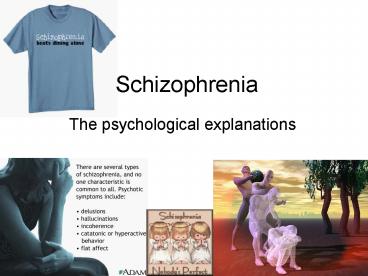The psychological explanations - PowerPoint PPT Presentation
1 / 18
Title:
The psychological explanations
Description:
EVALUATION OF PSYCHODYNAMIC THEORY ... The psychodynamic approach ignores the role of genetic factors. The behavioural approach ... – PowerPoint PPT presentation
Number of Views:45
Avg rating:3.0/5.0
Title: The psychological explanations
1
Schizophrenia
- The psychological explanations
2
Psychodynamic approach
- Freud argued that conflicts and traumas are
important in the development of schizophrenia. - Schizophrenics have regressed to a state of
primary narcissism. - In this state the ego has not separated from the
id. - As a result schizophrenics cannot interact with
reality as their ego does not function properly
3
EVALUATION OF PSYCHODYNAMIC THEORY
- It is very speculative, and is not supported by
much evidence. - The notion that adult schizophrenics resemble
infants in many ways is not very sensible. - The psychodynamic approach ignores the role of
genetic factors.
4
The behavioural approach
- Early experiences of punishment may lead children
to retreat into a rewarding inner world. This
leads to the child being given labels such as
odd. - According to Scheffs labelling theory,
individuals who have been labelled as odd or
peculiar may continue to act in ways that
conform to these labels.
5
BEHAVIOURAL APPROACH
- The bizarre behaviour may be rewarded through
attention and sympathy (a secondary gain). - The bizarre behaviour becomes increasingly
exaggerated, and is eventually labelled as
schizophrenia.
6
Constant reinforcement
Punishment
Withdrawal
Labelled as odd
Reinforced by attention
Conforming to label
7
Evaluation
- Schizophrenics often respond to reinforcement
when used in therapy. For example, schizophrenics
have learned to make beds, and comb their own
hair when rewarded for doing so (Ayllon and
Azrin) - Ignores genetic evidence
- Trivialises a very serious disorder.
8
Social factors
- Interpersonal communication (Bateson et al.s
double-bind theory) - Expressed emotion
- Stress
- The social causation hypothesis
- This hypothesis was designed to explain why it is
that schizophrenics tend to belong to the lower
social classes
9
DOUBLE BIND THEORY
- BATESON 1956- a factor causing Schizophrenia is
the destructive communication of family members - A mother may tell a child
- she loves him/her, but her
- tone of voice is not loving
10
EVALUATION
- MISHCLER AND WAXLER propose the opposite of
double bind theory - They proposed that the presence of a
Schizophrenic in a household causes the
communication problems - Evidence from this comes from the fact that
mothers, when talking to their schizophrenic
daughters were aloof and unresponsive, but
interact normally with their non-schizophrenic
daughters
11
SOCIAL CAUSATION HYPOTHESIS
- Schizophrenia is 8x more common amongst people of
lower social class - They tend to have more stressful lives because of
poverty, unemployment, poorer health, and
discrimination - Higher stress, according to the diathersis stress
model, makes people more vulnerable to
Schizophrenia
12
SOCIAL DRIFT HYPOTHESIS
- This proposes that people who develop
Schizophrenia are more likely to lose their jobs
and so social status is reduced. - So Schizophrenia reduces social status
- If this is the case, then Schizophrenics should
belong to a lower social class than their parents - TURNER AND WAGENFELD found that fathers of
Schizophrenics tended to belong to lower social
classes - This evidence supports social causation, not
social drift
13
STRESS
- DAY ET AL 1987 carried out a study in several
different countries. They found that
Schizophrenics tended to have experienced a high
number off stressful life events a few weeks
before the onset of the disorder
14
EXPRESSED EMOTION
- Despite lack of support for Double Bind theory,
there is evidence to show that family interaction
does play a role in maintaining symptoms in
Schizophrenics - The crucial factor is the amount of expressed
negative emotion, e.g. shouting, criticising,
hostility
15
EVIDENCE FOR EXPRESSED EMOTION
- KAVANAGH 1992 found that schizophrenics who
live in families with high EE are four times more
likely to relapse than those in families with low
EE
16
EVALUATION
- Cause and effect have not been established
- Does the family casue the relapse of the
individual? - OR
- Does the presence of the individual casue the
expressed emotion?
17
DIATHESIS STRESS MODEL
- This proposes that a mental disorder involves a
predisposition to the disorder (biological) and a
stressor which triggers the disorder - There is a clear genetic link with schizophrenia
but not everyone who inherits the gene goes on
to develop the disorder
18
TREATMENT
- If the cause of a disorder is biological, then
the treatment should be biological - Schizophrenia is most commonly treated with drugs
- However these provide relief, but are not a cure































![[PDF⚡READ❤ONLINE] Psychological Science and the Law PowerPoint PPT Presentation](https://s3.amazonaws.com/images.powershow.com/10047341.th0.jpg?_=20240604103)